 |
Picks is a monthly sampling of Japan's art scene, offering short reviews of exhibitions at museums and galleries in recent weeks, with an emphasis on contemporary art by young artists. |
 |
 |
|
|
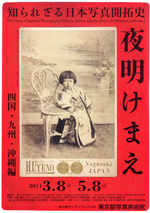 |
 |
 |
 |
| The Dawn of Japanese Photography: Shikoku district, Kyushu district & Okinawa prefecture |
| 8 March - 8 May 2011 |
Tokyo Metropolitan Museum of Photography
(Tokyo) |
 |
| The third in a series, this show features some of the earliest photographs taken in Japan in the mid-1800s, before the end of the Shogunate. Following previous installments that focused on the Kanto and Chubu/Kinki/Chugoku regions, the current one assembles original and duplicate prints from western Japan. Surveys sent out to around 2,200 museums, libraries and other institutions in Shikoku, Kyushu and Okinawa yielded dozens of originals that had previously been undiscovered or overlooked. Among the most intriguing are the three "Baudin Albums" of photos collected by the Bauduin brothers in Nagasaki (Anthonius taught at Nagasaki Hospital and Alphonse was the Dutch consul there). |
|
 |
|

|
 |
 |
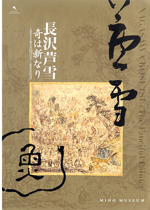 |
|
Nagasawa Rosetsu: The Fanciful Painter |
| 12 March - 5 June 2011 |
Miho Museum
(Shiga) |
 |
| This major retrospective offers some 110 works by Nagasawa Rosetsu (1754-99). A student of the renowned late Edo Period painter Maruyama Okyo (1733-95), Rosetsu gradually weaned himself from his teacher's style, moving into what was then radical territory with unconventional techniques, variegated subject matter, and irreverent humor. The show bears ample witness to the curiosity, creative drive, and playful outlook that infuse all of Rosetsu's work. Particularly eye-catching are his large screen paintings, at once meticulous and dynamic, of tigers, elephants and other exotic animals. |
|
|
 |
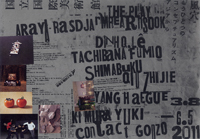 |
|
Kaza Ana / Air Hole: Another Form of Conceptualism from Asia |
|
|
The National Museum of Art, Osaka
(Osaka) |
 |
| Eight artists and art units from China, Thailand, Japan and elsewhere (The Play, Araya Rasdjarmrearnsook, Dinh Q. Le, Fumio Tachibana, Shimabuku, Qiu Zhijie, Yuki Kimura, contact Gonzo) offer a decidedly East Asian take on conceptual art. One installation that transcends whimsy or parody and borders on the anthropological is Araya's video series of Thai villagers viewing and commenting on impressionist paintings by Renoir, Manet, and the like. The museum explains the show title thusly: "Kaza-ana (air hole) refers to a crack through which wind blows. Artists seek out and expand the fissures in rules, domains and objects. Conceptualism dismantles old frames of reference and invites fresh breezes to blow through them." |
|
|
|
|
|
|
|

|
 |
 |
|
|
|
|
|
 |
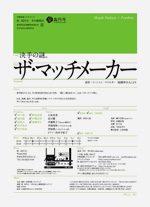 |
 |
|
|
Shigeki Nakano + Frankens: The Matchmaker
|
|
25 February - 6 March 2011
|
ZA-KOENJI Public Theatre
(Tokyo) |
 |
| The Shigeki Nakano + Frankens theater company specializes in plays translated from other languages. Recently they produced Thornton Wilder's classic comedy The Matchmaker at Za-Koenji, a contemporary performing arts complex in western Tokyo. The troupe effectively utilizes wordplay, some of it based on deliberate mistranslation, to set up a tumbling rhythm to the dialogue and elicit plenty of laughs. The denouement, with its wacky pastiche of missing wallets, false identities and cross-dressing, is part slapstick, part cultural anthropology. |
|
|
|
|
|
|
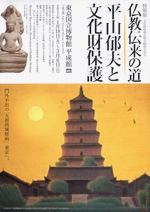 |
 |
|
|
Hirayama Ikuo and the Preservation of Buddhist Heritage
|
|
18 January - 6 March 2011
|
Tokyo National Museum
(Tokyo) |
 |
| Famed for his landscapes of central Asian deserts along the Silk Road, Nihonga painter Hirayama (1930-2009) dedicated his life to the preservation of Buddhist statuary, murals and other cultural treasures in that part of the world. This show displays works of art from places Hirayama visited in India, Pakistan, Afghanistan, Western China, and Cambodia alongside his own work. A highlight is the 37-meter long Daito Saiiki mural series depicting the introduction of Buddhism from India to China, a masterpiece that took Hirayama 20 years to complete for the Yakushiji temple in Nara. |
|
 |
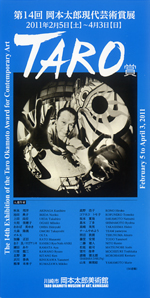 |
 |
|
| The 14th Taro Okamoto Award for Contemporary Art |
| 5 February - 3 April 2011 |
Taro Okamoto Museum of Art, Kawasaki
(Kanagawa) |
 |
| Named after the ubiquitous icon of the Japanese avant-garde, this year's TARO Awards bestowed the late master's blessings on a variety of works displayed in this annual show (the 13th) at the eponymous museum. The Taro Okamoto Award went to Orta's massive shrine of straw, bamboo and earth, and the Toshiko Okamoto award to Toshitaka Mochizuki's images of scattered female figures, all clothed in black, with black hair obscuring their faces. Special Award winners were Hiroko Takano's towering pile of wooden bookcases, Takahiro Ueda's particle accelerator-like object, Mikiko Kumazawa's paintings and Kentaro Morohashi's installation. |
|
|
|
|
 |
|
|
 |
|